Menus
- The mix of tourers, fun bikes and athletes
- MOTORRAD points evaluation / conclusion
- Technology news: the valve trick
- The competition
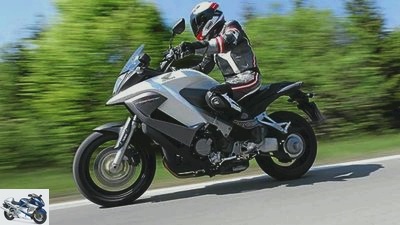
Jahn
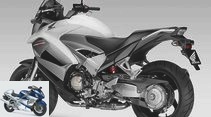
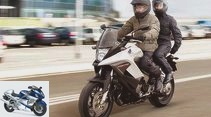
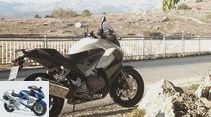
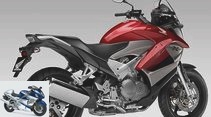
13 photos
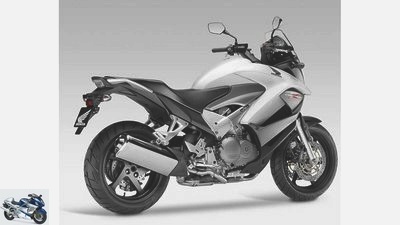
Honda
1/13
Honda Crossrunner
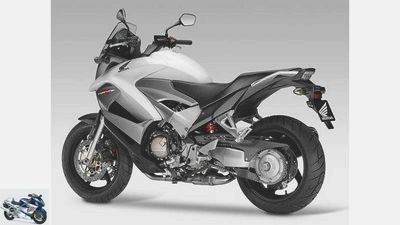
Honda
2/13
Honda Crossrunner
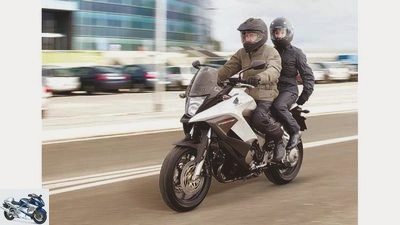
Honda
3/13
Honda Crossrunner
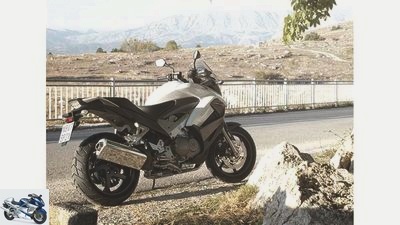
Honda
4/13
Honda Crossrunner
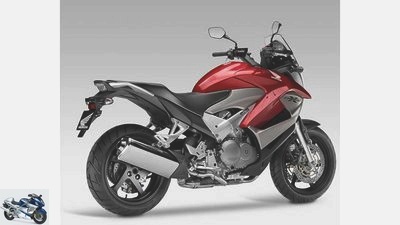
Honda
5/13
Honda Crossrunner
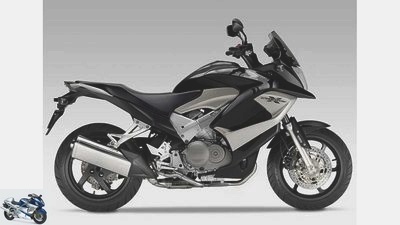
Honda
6/13
Honda Crossrunner
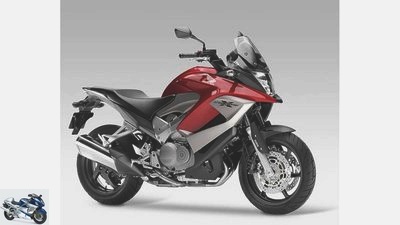
Honda
7/13
Honda Crossrunner
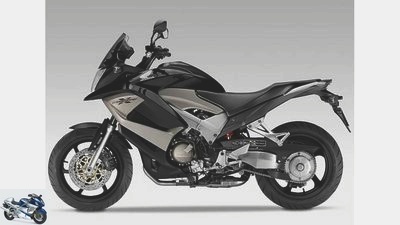
Honda
8/13
Honda Crossrunner
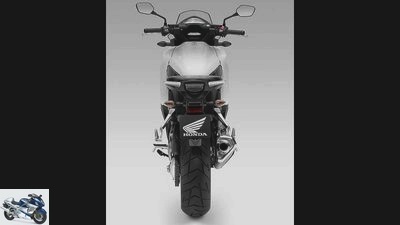
Honda
9/13
Honda Crossrunner
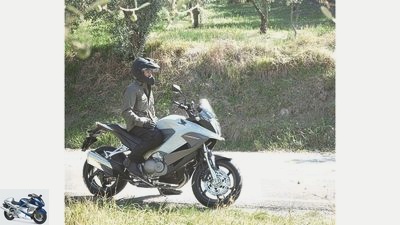
Honda
10/13
Honda Crossrunner
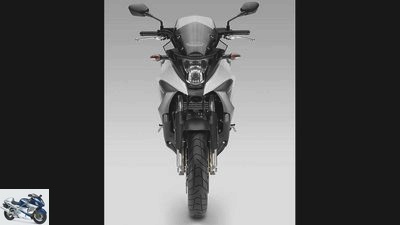
Honda
11/13
Honda Crossrunner

Honda
12/13
Honda Crossrunner
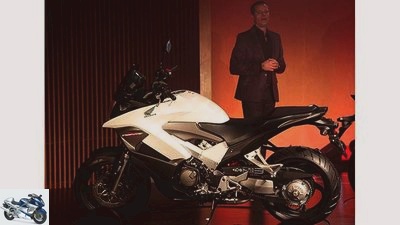
Gori
13/13
Presentation of the Honda Crossrunner at the Honda press conference.
Top test: Honda Crossrunner
The mix of tourers, fun bikes and athletes
The new Crossrunner has everything in it: a little touring bike, a lot of fun bike, a bit of an athlete – a mix of many good hereditary traits. And it’s a male, because according to Honda it’s called the Crossrunner and not the Crossrunner. Good dog?
Give in! Kill! Stay (on the chosen line)! The C.Rossrunner obeys every word. Good genetic makeup or good upbringing? Both. The driver doesn’t even have to be particularly strict, because the new Honda offspring willingly follows the commands and requires little effort. One of the inherited strengths is undoubtedly the very healthy, almost indestructible V4 heart from mother VFR. Even in the sports tourer with 109 hp, not too much designed for maximum performance, but more for endurance and even power output, the engine in the Crossrunner should prove to be more robust than ever with its moderate tuning aimed at more torque and only 102 hp maximum output. Modifications to the V-TEC valve control, the injection as well as the ignition should ensure fuller power output in the lower speed range, and the transition from two- to four-valve operation should be smoother and less drastic. Frame, the single-sided swing arm, drive train, even the gear ratio and the final ratio – all identical to the VFR. The brakes (ABS and the CBS combination brake are standard equipment on board) are also familiar from the sports tourer. The differences only continue in the area of ergonomics, the suspension elements and the exhaust system. The four-in-two-in-one system leads to a rear silencer that is mounted low on the side, which enables the seating arrangement to be designed with a low seat height, although the spring travel on the Crossrunner is longer, which promotes comfort, and the ground clearance has increased by 15 millimeters.
Buy complete article
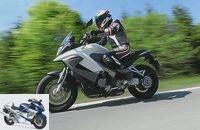
Top test: Honda Crossrunner
The mix of tourers, fun bikes and athletes
Jahn
Neutral cornering behavior and good lean angle ensure driving pleasure.
The athlete in the V4 tier wakes up at 6500 rpm. Here Doctor Zweiventiler is transformed into Mister Vierventiler and shows the dark side of his being. A noticeably fresh wind suddenly blows, nastily the four-cylinder pulls horse and rider forward and dashes under a well-muffled, yet very melodious V4 rumble towards the limiter, which locks at just under 12,000 rpm. The command given briefly at the traffic light stop "Run! Get the sports car from Zuffenhausen!" is no problem for the Honda hybrid. Throttle twice, shifting twice, and the cult car with the roaring six-cylinder boxer engine in the rear has caught up and overtaken despite the unfair early start. Once the crossrunner has taken in the weather or even tasted blood, there is hardly anything in the way of wild curve hunting beyond the city limits. With a live weight of at least 239 kilograms, the Crossrunner can be thrown from one lean angle to the other with astonishing ease, steers very precisely and always remains extremely neutral. Even standing up when braking in an inclined position is hardly an issue, the pleasantly comfort-oriented adjustment of the non-adjustable fork takes its revenge only when driving at a very brisk ride over an undulating road, and the load begins to pump easily. In extreme cases, the front wheel loses contact with the ground and moves towards the edge of the curve. Little dramatic and quite predictable.
The pleasant effects of this tuning are the good response of the fork to both small and large bumps and the comfort that is always offered. The Honda irons even over lousy patchwork slopes pretty unmoved. The soling of the 800s is also excellent: The Pirelli series paws of the Scorpion Trail type claw their way mercilessly into the asphalt even on the steepest slopes and do not cause any wobbly or annoying life of their own. You can always rely on the well-known and proven Honda combi brake and ABS. The three-piston calipers at the front offer excellent bite and decent deceleration, which can be finely adjusted. The perfectly working ABS reliably prevents the wheels from locking; if it were to regulate it at slightly shorter intervals, the braking distances could be shortened even further. A forced driving style also has its price with the Crossrunner: The very precise on-board computer, which also displays the current and average consumption, reports a value of well over seven liters per 100 kilometers after 50 angry kilometers. Normally fast country road driving only has a value of around five liters.
Jahn
Far from practical: No one can read the low-contrast bar segment tachometer in direct sunlight.
So much for the topic of fun and sportiness – how does the Crossrunner keep up with comfort and suitability for travel? The sitting posture can easily be withstood over long distances, despite the sporty leg angle, although the windshield, which is not too high, at most relieves the upper body a little, but exposes the shoulders and head to the wind. After all, no booming or turbulence, and the driver can withstand high freeway speeds for quite some time. The view in the sweeping mirrors can be described as good, and the view to the rear is often important because you are not among the fastest here. At 200 km / h it is sealed off, the (identical to the VFR) with a much too long geared Crossrunner manages this speed in the sixth (given only around 85 hp at the corresponding speed), often with difficulty, in the fifth (at 10,000 rpm sealed off) ends at 193 km / h. Logically, the pull rates suffer as well.
There is nothing wrong with the stability at high speeds, however, and those who settle down to a medium travel speed can expect reasonable consumption and will roll to the next gas station after around 350 to 400 kilometers. This only applies to a limited extent for the front passenger, the notches, which are mounted quite high, allow them to sit somewhat cramped with strongly bent legs on their sufficiently dimensioned spot. What is Honda’s characterization of her youngest creature: a combination of a performance naked bike and an adventure bike. Well, useful details for adventures far away from home, such as the main stand (helpful when tensioning the chain), luggage rack or a better protective, higher disc are all accessories that are subject to a surcharge. And the payload is also acceptable at 194 kilograms for long-distance trips for two, but not lush. So what is the Crossrunner: problem-free everyday bike, nimble fun bike, comfortable tourer? Following the crossover idea, the new Honda does not turn out to be perfect in any of the disciplines mentioned, but it does pretty well in all of them. So it would be no wonder if the new Honda hybrid, which is happily calculated at 10,790 euros, is in command "stay" (standing at the dealer) disregard and would go from cross runner to best seller.
MOTORRAD points evaluation / conclusion
Jahn
Stable, well-shaped handles enable the passenger to hold on securely.
engine
The smooth-running V4 engine is considered to be extremely durable and delights with fine manners. Despite the V-TEC trick, which combines the advantages of two- and four-valve technology, the pull-through measured values are mediocre. This is largely due to the long final gear ratio of the precisely shiftable six-speed transmission. The last stage almost mutates into a gentle gear, because the top speed, which is limited to 200 km / h, is almost reached in the fourth.
landing gear
The Honda, which weighs 239 kilograms, is astonishingly light-footed and can be driven through tight alternating curves. In a predictable and neutral way, it also circles long, fast arcs, the respectable freedom of inclination allows high cornering speeds. The non-adjustable fork offers a good compromise between comfort and sportiness, the Crossrunner irons even over lousy slopes with ease.
everyday life
A bike for all occasions – this phrase applies exactly to the crossrunner. The relaxed, active driving posture and the uncomplicated operation are pleasing in everyday life, as are the practical good visibility in the mirrors and the excellent light. The windshield is not great, but is okay, the displays in the cockpit are numerous (laudable: the exact consumption display), but the tachometer is very difficult to read.
security
Foolproof driving behavior without the hassle of standing up when braking or hitting the handlebars can be attested to by the Crossrunner. The crisp brakes are confidently controlled by the ABS, but shorter control intervals could shorten the braking distance even further.
costs
Favorable consumption and long inspection intervals of 12,000 kilometers give the Crossrunner, which is cheap to buy, important points here. Two years guarantee is standard.
Max points
Price-performance
The respectable number of points in connection with the quite fair purchase price of 10,790 euros help the Crossrunner achieve a deserved good price-performance rating.
Conclusion
The crossrunner is a compromise. And a successful one. It is also more than a stripped VFR with high handlebars and poaching successfully in many areas without being perfect in one area. Whether as a fun bike for robbing passports, as a comfortable travel bike or as a reliable everyday companion – the Crossrunner is available for everything. In addition, at a relatively low price. Well done!
archive
The performance diagram of the Honda Crossrunner.
engine
Water-cooled four-cylinder four-stroke 90 degree V-engine, two overhead, chain-driven camshafts, four valves per cylinder, bucket tappets, wet sump lubrication, injection Ø 36 mm, regulated catalytic converter with secondary air system, alternator 386 W, battery 12 V / 11 Ah, Hydraulically operated multi-disc oil bath clutch, six-speed gearbox, O-ring chain, secondary ratio 43:16.
Bore x stroke 72.0 x 48.0 mm
Cubic capacity 782 ccm³
Compression ratio 11.6: 1
rated capacity 75.0 kW (102 hp) at 10,000 rpm
Max. Torque 74 Nm at 9250 rpm
landing gear
Bridge frame made of aluminum, telescopic fork, Ø 43 mm, single-sided swing arm made of aluminum, central spring strut with lever system, adjustable spring base and rebound damping, double disc brake at the front, Ø 296 mm, three-piston floating calipers, rear disc brake, Ø 256 mm, two-piston floating caliper, partially integral brake system with ABS.
Cast aluminum wheels 3.50 x 17; 5.50 x 17
Tires 120/70 ZR 17; 180/55 ZR 17
Tires in the Pirelli Scorpion Trail test
Dimensions + weights
Wheelbase 1464 mm, steering head angle 64.6 degrees, caster 96 mm, spring travel f / h 165/145 mm, permissible total weight 433 kg, tank capacity 21.5 liters.
Service data
Service intervals 12,000 km
Oil and filter change every 12,000 km 3.1 l
Engine oil SAE10W30
Telescopic fork oil SAE 10
Spark plugs IMR9D-9H NGK, VNH27Z Denso
Idle speed 1200 ± 100 / min
Tire pressure solo (with pillion passenger) front / rear 2.3 / 2.5 (2.3 / 2.5) bar
Two year guarantee
Colors red, black, white
price 10 790 euros
Additional costs around 170 euros
MOTORCYCLE measurements
Performance
Top speed * 200 km / h
acceleration
0-100 km / h 3.7 sec
0-140 km / h 6.2 sec
0-200 km / h 16.4 sec
Draft
60-100 km / h 5.6 sec
100-140 km / h 6.5 sec
140-180 km / h 9.2 sec
Noticed:
positive
The adjustable clutch lever is a praiseworthy comfort and safety feature that is important for riders with small hands, which unfortunately is still not part of the standard equipment on all bikes. The fairly accurate consumption display in the cockpit allows a precise calculation of the range. By the way: when the fuel gauge starts to flash, there are still around five liters of fuel on board, which is enough for a good 100 kilometers if you drive gently.
negative
The on-board tools are quite poor in quantity and quality. A little more would certainly not have exceeded the budget. Locking the removed bench turns into fiddling, because at the same time that the bench is pressed down and locked into place, two retaining lugs have to be threaded into tabs on the side of the tank. You’ve seen it easier at Honda too.
Technology news: the valve trick
Honda
Everything in the rest position: the cam points upwards, the bucket tappet is pushed upwards by the spring. In action: the cam presses the bucket tappet down, the pawl (red) is not engaged, the valve is not opened.
Engine builders usually have to decide: sparkling wine or seltzer, country or western, two or four valve engines? Both variants have their advantages and disadvantages due to their principle. Two valves per cylinder require less technical effort, are more cost-effective, and cause less mechanical noise. In terms of performance, at low and medium speeds they offer the advantage of the higher speed of the incoming combustion mixture, as the intake pressure is higher due to the overall smaller inlet cross-section. Disadvantage: The cross-section limits the degree of filling and thus the maximum output at high speeds. This is where the advantage of four-valve technology comes into play: Two smaller inlet valves together offer more area through which the gas can flow than a large one, the better filling level enables higher peak performance. Conversely, the statements made with the two-valve valve apply with the opposite sign, i.e. they represent disadvantages of the four-valve valve.
V-TEC combines the advantages of both systems. At a clearly defined speed (here around 6500 rpm), the oil pressure reaches a value that pushes a previously ineffective pawl in a guide over the valve stem, which means that the cam now pushes the valve down, i.e. activates it, which causes the Valve opens the inlet (or outlet) channel and ensures a higher gas throughput. The two-valve engine thus becomes a four-valve engine from this speed.
The competition
The KTM 990 SM T.
KTM 990 SM T
Two-cylinder 75-degree V-engine, six-speed, 116 HP, weight 218 kg, 0-100 km / h: 3.6 sec, Vmax: 220 km / h, consumption 6.5 liters, price 12 595 euros
Triumph Tiger 800
Three-cylinder in-line engine, six-speed, 95 hp, weight 220 kg, 0-100 km / h: 3.7 sec, Vmax: 210 km / h, consumption 4.5 liters, price: 9,390 euros (including ABS)
Yamaha TDM 900
Two-cylinder in-line engine, six-speed, 86 hp, weight 237 kg, 0-100 km / h: 3.9 seconds, Vmax: 210 km / h, consumption 5.0 liters, price: 10 850 euros
Related articles
-
Honda Crossrunner and Crosstourer DCT in the test
Bilski Family duel: Honda Crossrunner and Crosstourer DCT Honda Crossrunner or Crosstourer DCT? Crusaders are commonly found on the world’s seas. But…
-
Honda NC 700 X – the new tourer at a budget price
Top-Test: Honda NC 700 X The all-rounder from Honda at a budget price In line with the new driving license regulations (from 2013), Honda is already …
-
Honda Crossrunner – the new sports tourer from Honda
fact Premiere Honda Crossrunner The new sports tourer from Honda Content of Take a sports tourer that is getting on in years, give it long legs and a…
-
Kawasaki Versys 1000, Triumph Tiger 1050 Sport, Honda Crossrunner in comparison test
28 pictures 1/28 After the romping comes the touring: petrol talks at the former coal port in Karlsruhe ….
-
Krieger 12 pictures Sven Krieger 1/12 cult bike Honda CB 450.Sven Krieger 2/12 Among the descendants: machines like the CB 500 (left) have long been part of the …
-
BMW, Kawasaki, Yamaha and Honda Tourer in comparison
Kunstle 21 pictures 1/21 The story of a seven-day trip with a simultaneous comparison test around the Baltic Sea with the tourers: BMW K 1600 GT, …
-
Honda Crossrunner in the driving report
Honda 20 pictures Honda 1/20 Honda Crossrunner. Honda 2/20 Honda Crossrunner. Honda 3/20 Honda Crossrunner. Honda 4/20 Honda Crossrunner. Honda 5/20 Honda …
-
Driving report: Honda Crossrunner
Honda Driving report: Honda Crossrunner The best compromise in the motorcycle world? Not that it screwed up the first, on the contrary: the VFR was an…
-
factstudio.de 15th photos factstudio.de 1/15 Honda CB 1000 R + in the top test. factstudio.de 2/15 The design line of the new CB 1000 R is called “Neo…
-
Archive 10 pictures fact 1/10 cult bike Honda XBR 500.Bilski 2/10 cult bike Honda XBR 500. Archive 3/10 cult bike Honda XBR 500. Holzwarth 4/10 cult bike Honda …